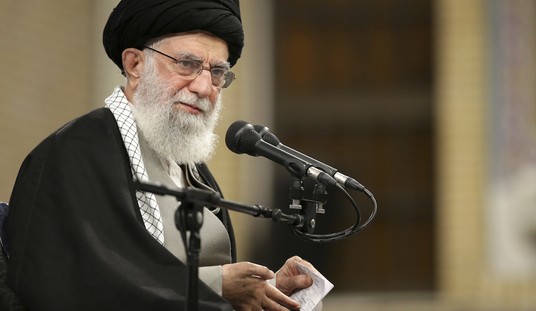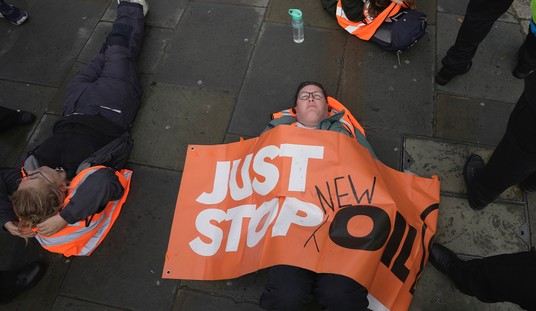Just by happenstance, I had to follow Professor Alan Dershowitz on Newsmax Saturday morning. That may not be quite as daunting as following Herman Cain on stage, but it’s close. My segment focused on the political impact of the January 6 hearing, while Dershowitz covered the Big Kahuna of legal stories — the overturning of Roe in the Dobbs decision.
Thanks to the juxtaposition, I got a ringside seat of sorts to this exchange between Dershowitz and Newsmax host Mike Carter. I expected Dershowitz to fully oppose the Dobbs decision and defend Roe, and Carter may have expected that as well. Instead, Dershowitz became one of the few people on either side who defended Chief Justice John Roberts. Samuel Alito and the other four justices engaged in “judicial activism,” Dershowitz complained, by deciding a case not before them. They should have stuck to the actual case in Dobbs, Dershowitz argued, upholding the 15-week abortion ban in Mississippi while leaving Roe for a more direct challenge.
I disagree, but it’s still a very interesting argument:
“I was also skeptical of Roe v. Wade, but this is not the case to make that decision,” Dershowitz told Saturday’s “America Right Now” host Mike Carter. “You wait until you have to make a decision overruling a prior case. That’s what judicial restraint is all about.”
Dershowitz also told Carter that the Supreme Court justices “made the decision they didn’t have to make.”
“When Mississippi sought review in the Supreme Court, they said you don’t have to overrule Roe v. Wade: The only issue is whether a ban on abortion after 15 weeks is unconstitutional,” Dershowitz said.
“What the Supreme Court did is engage in outrageous judicial activism. They reached out to decide an issue not before them. They violated their own constitutional powers. The Supreme Court has the power only to decide cases and controversies. They do not have the power to issue advisory opinions. And this is a self-inflicted wound. What we’re seeing on the streets is absolutely unnecessary.”
Carter initially didn’t grasp the nuance here and argued instead about stare decisis more generally, invoking the Brown reversal of Plessy. Dershowitz correctly notes, though, that Brown directly and explicitly targeted the core question in Plessy. Dobbs, Dershowitz argues, didn’t target the core argument in Roe, which means that Roberts’ compromise was the proper path of judicial restraint:
“All the Supreme Court had to do was follow Chief Justice [John] Roberts’ statements,” Dershowitz told Carter. “Roberts wrote an opinion saying the issue of Roe v. Wade is not before us. It’s only 15 weeks, but these agenda-driven five judges decided they had to reach out and the side that issue, improperly, not before them.
“So, without even deciding whether Roe v. Wade should or should not be overruled, this was not the case to do it,” Dershowitz reiterated. “That’s simple. And the Supreme Court should never never have decided whether to overrule Roe v. Wade in a case not presenting that issue.”
Roberts didn’t convince anyone on the court of this position, however, and for good reasons. He didn’t get any of the three liberal justices, whose dissent relied more on their views of social policy than on the law, nor any of the conservative justices that saw Roe as fatally flawed. If Dershowitz was correct, one might have expected an institutionalist like Brett Kavanaugh to come along with Roberts, and maybe even Elena Kagan on the other side to form a centrist core that might shed Casey while leaving Roe intact. (In fact, everyone had predicted that Roberts would try that very ploy. The big surprise is that he ended up concurring in Dobbs rather than stand apart in a 5-3-1 decision.)
The problem isn’t judicial activism in this case, but the actual structure of Roe. Perhaps this point escaped Dershowitz — not much does — but the 15-week abortion ban would have squarely contradicted Roe’s viability standard. The common understanding of Roe is that it barred regulation of abortion in the first trimester, but it went farther than that in the decision itself. It mentions “viable” or “viability” nine times, and sets the standard for regulation at that point:
It should be sufficient to note briefly the wide divergence of thinking on this most sensitive and difficult question. There has always been strong support for the view that life does not begin until live birth. This was the belief of the Stoics.56 It appears to be the predominant, though not the unanimous, attitude of the Jewish faith.57 It may be taken to represent also the position of a large segment of the Protestant community, insofar as that can be ascertained; organized groups that have taken a formal position on the abortion issue have generally regarded abortion as a matter for the conscience of the individual and her family.58 As we have noted, the common law found greater significance in quickening. Physicians and their scientific colleagues have regarded that event with less interest and have tended to focus either upon conception, upon live birth, or upon the interim point at which the fetus becomes ‘viable,’ that is, potentially able to live outside the mother’s womb, albeit with artificial aid.59 Viability is usually placed at about seven months (28 weeks) but may occur earlier, even at 24 weeks.60 …
This means, on the other hand, that, for the period of pregnancy prior to this ‘compelling’ point, the attending physician, in consultation with his patient, is free to determine, without regulation by the State, that, in his medical judgment, the patient’s pregnancy should be terminated. If that decision is reached, the judgment may be effectuated by an abortion free of interference by the State.
With respect to the State’s important and legitimate interest in potential life, the ‘compelling’ point is at viability. This is so because the fetus then presumably has the capability of meaningful life outside the mother’s womb. State regulation protective of fetal life after viability thus has both logical and biological justifications. If the State is interested in protecting fetal life after viability, it may go so far as to proscribe abortion during that period, except when it is necessary to preserve the life or health of the mother.
Alito points this out at the very beginning of his opinion in Dobbs:
Under this scheme, each trimester of pregnancy was regulated differently, but the most critical line was drawn at roughly the end of the second trimester, which, at the time, corresponded to the point at which a fetus was thought to achieve “viability,” i.e., the ability to survive outside the womb. Although the Court acknowledged that States had a legitimate interest in protecting “potential life,”1 it found that this interest could not justify any restriction on previability abortions. The Court did not explain the basis for this line, and even abortion supporters have found it hard to defend Roe’s reasoning.
In 1992, the Casey court would reaffirm and strengthen that prohibition against regulation before the “compelling interest” point of viability, but it’s present in Roe as well. That left Alito and the majority in Dobbs with two choices if they wished to uphold the Mississippi law: either to overturn Roe entirely, or rejigger and reissue Roe to remove the viability standard. That would have left succeeding courts with even less room to offer a direct challenge to Roe in the manner that Dershowitz suggests, as such a move as Roberts suggested would have strengthened the court’s illegitimate grip on the regulatory functions of abortion law.
More to the point, though, such a move would have completely undermined even the fatally flawed logic of Roe. The court ruled in 1973 that the state didn’t have a compelling interest in protecting human life prior to the point of viability. If Dobbs had ruled that the state did have a compelling interest prior to viability, then at what point would it start? Absent viability, what’s the objective standard other than conception? One could argue for a heartbeat standard, which is at least a bit more objective than the ambiguous and shifting line of “viability,” but that should be a question left to the legislatures. It’s a policy question, not a constitutional question.
To get to Roberts’ preferred outcome, as I noted on Friday, one would have to dismantle Roe and then reconstruct it. For what purpose? To leave it dangling for a future court and to keep states guessing as to a standard other than judicial whim? That would have been judicial activism of the worst kind — judicial activism to salvage another case of judicial activism.
Besides, as Alito wrote in addressing Roberts’ concurrence, both parties had at the end urged an all-or-nothing decision on Roe, a point Dershowitz elides in this argument:
There are serious problems with this approach, and it is revealing that nothing like it was recommended by either party. As we have recounted, both parties and the Solicitor General have urged us either to reaffirm or overrule Roe and Casey. See supra, at 4–5. And when the specific approach advanced by the concurrence was broached at oral argument, both respondents and the Solicitor General emphatically rejected it. Respondents’ counsel termed it “completely unworkable” and “less principled and less workable than viability.” Tr. of Oral Arg. 54. The Solicitor General argued that abandoning the viability line would leave courts and others with “no continued guidance.” Id., at 101. What is more, the concurrence has not identified any of the more than 130 amicus briefs filed in this case that advocated its approach. The concurrence would do exactly what it criticizes Roe for doing: pulling “out of thin air” a test that “[n]o party or amicus asked the Court to adopt.” Post, at 3.
The concurrence’s most fundamental defect is its failure to offer any principled basis for its approach. The concurrence would “discar[d]” “the rule from Roe and Casey that a woman’s right to terminate her pregnancy extends up to the point that the fetus is regarded as ‘viable’ outside the womb.” Post, at 2. But this rule was a critical component of the holdings in Roe and Casey, and stare decisis is “a doctrine of preservation, not transformation,” Citizens United v. Federal Election Comm’n, 558 U. S. 310, 384 (2010) (ROBERTS, C. J., concurring). Therefore, a new rule that discards the viability rule cannot be defended on stare decisis grounds.
Roberts argued in his concurrence that the viability principle in Roe could be severed from the constitutional right, but Alito correctly notes that viability is the main connecting threat between Roe, Casey, and other antecedents. Furthermore, absent a viability standard, on what basis could states proscribe abortion at all, as the law in Dobbs would do? Roberts’ suggestion of a “reasonable opportunity” standard is even more ambiguous than “viability,” Alito argued in rebuttal:
For all these reasons, stare decisis cannot justify the new “reasonable opportunity” rule propounded by the concurrence. If that rule is to become the law of the land, it must stand on its own, but the concurrence makes no attempt to show that this rule represents a correct interpretation of the Constitution. The concurrence does not claim that the right to a reasonable opportunity to obtain an abortion is “‘deeply rooted in this Nation’s history and tradition’” and “‘implicit in the concept of ordered liberty.’” Glucksberg, 521 U. S., at 720–721. Nor does it propound any other theory that could show that the Constitution supports its new rule. And if the Constitution protects a woman’s right to obtain an abortion, the opinion does not explain why that right should end after the point at which all “reasonable” women will have decided whether to seek an abortion. While the concurrence is moved by a desire for judicial minimalism, “we cannot embrace a narrow ground of decision simply because it is narrow; it must also be right.” Citizens United, 558 U. S., at 375 (ROBERTS, C. J., concurring). For the reasons that we have explained, the concurrence’s approach is not.
In this case, Professor Dershowitz is wrong, and so was Roberts. The parties in this case may not have started out with a direct challenge and defense of Roe, but that changed when they came to the Supreme Court. Furthermore, there is no rational way to uphold Dobbs while keeping Roe in place, as it directly contradicts the Roevian “compelling interest” standard of viability, especially as defined in the decision. This was the case in which these issues should have been decided, and by returning abortion policy back to the people through their legislatures, this court restored the constitutional order that Roe perverted.
It’s still a fascinating argument nonetheless. Kudos to both Newsmax and Dershowitz for airing it, as Dershowitz himself notes at the end.








